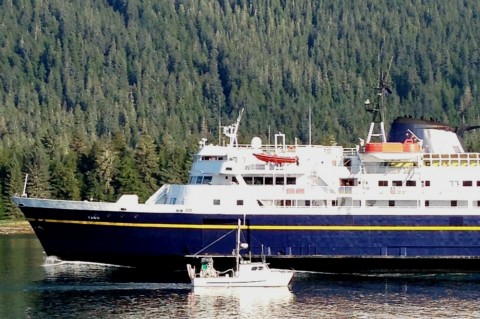Next winter’s ferry schedule will be leaner than this year’s, and that was pretty lean. It’s the result of budget cuts, which could lead to the sale of the ferry Taku.

A couple of numbers tell the story of the next budget year’s ferry schedule.
The first is 356. That’s the number of weeks ships are sailing during this fiscal year, which ends in June. The second is 330, the number of weeks of sailings for the next budget year, which begins in July. That adds up to a reduction of around 7 percent.
Dennis Egan is a state senator representing Juneau, Haines and Skagway, all with strong ferry system connections.
“What happened this legislative session, I don’t like at all,” Egan said. “I think it’s decimated the Marine Highway System and the problem is a lot of people don’t understand that it’s a highway. Sure it costs money to run, but we pay for a lot of it.”
This next year’s total budget, in its latest version, is almost 10 percent lower that this year’s spending plan. And some of the money will come out of an account that’s being spent down quickly.
Ferry spokesman Jeremy Woodrow says cuts will be most visible later this year.
“It is not the department’s intention to change any of the summer schedule,” Woodrow said. “Any changes will be reflected in the winter schedule or next spring and the beginning part of summer, 2017.”
In all, five of the state’s 11 ferries will tie up for much of the fall-winter-spring schedule. That includes both fast ferries, the Kennicott and the Columbia.
The other tied-up ferry is the Taku, which hasn’t sailed since last July.
Woodrow says officials are researching what needs to be done to sell it off. And that’s not restricted to outside buyers.
“There has been a lot of discussion of different ferry authorities, … potentially communities creating their own ferry authorities to improve ferry service,” Woodrow said. “So, those are some of the discussions that are being had of what to do with the Taku.”
The ferry system estimates it spends about $3 million a year to lay up the ship. That covers a skeleton crew, insurance and a fuel for the generators. So selling it off would reduce operating costs. There are other factors, such as the ship’s age and condition.
Ketchikan Rep. Dan Ortiz, who also represents Wrangell, said he’s concerned about the loss of a ship that’s served Southeast for years.
“It’s been a mainstay,” Ortiz said. “And while it would require some refurbishment and some significant moneys to do that, I want to make sure that in the long run, it wouldn’t be more cost-effective to do that refurbishment rather than to build another ferry or something like that.”
Ferry officials are taking written comments on the fall-winter-spring schedule through June 21st. A teleconference is planned for the following day.
Ed Schoenfeld is Regional News Director for CoastAlaska, a consortium of public radio stations in Ketchikan, Juneau, Sitka, Petersburg and Wrangell.
He primarily covers Southeast Alaska regional topics, including the state ferry system, transboundary mining, the Tongass National Forest and Native corporations and issues.
He has also worked as a manager, editor and reporter for the Juneau Empire newspaper and Juneau public radio station KTOO. He’s also reported for commercial station KINY in Juneau and public stations KPFA in Berkley, WYSO in Yellow Springs, Ohio, and WUHY in Philadelphia. He’s lived in Alaska since 1979 and is a contributor to Alaska Public Radio Network newscasts, the Northwest (Public Radio) News Network and National Native News. He is a board member of the Alaska Press Club. Originally from Cleveland, Ohio, he lives in Douglas.




